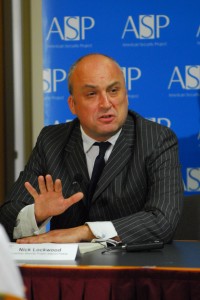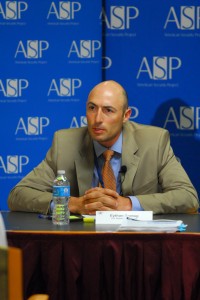This afternoon American Security Project in conjunction with Development Transformations hosted “The Future of Stability Operations: Lessons from Afghanistan,” a panel discussion centered on the challenges U.S. stability strategies have faced and prescriptions for moving forward.
Participating in the discussion were Nick Lockwood, Development Transformation’s Director of International Operations and ASP adjunct fellow; Eythan Sontag of the Bureau of Conflict and Stabilization Operations (CSO); Lt. Gen. Frank Kearney III, USMC (Ret.) and President of Inside Solutions LLC.; Howard Clark, former Marine, intelligence officer at Homeland Security, and author; and moderator BGen. Stephen Cheney, USMC (Ret.) and ASP CEO.
After an introduction of the panel, Lockwood began by looking at how U.S. agencies, from military to civilian, define stability—noting that none of these definitions sufficed. Stability operations should not center on disaster relief or humanitarian aid, as agencies such as USAID tend towards, nor should they be defined within the military spectrum of defense or offense.
Lockwood observed, “particularly in a time of great austerity,” agencies defer to “what they’re good at,” whether it be developing infrastructure or healthcare systems, but “in the short term it’s really about security and justice.” Successful stability operations require people and skills with institutions capable of acting.
Sontag continued by outlining some of the new facets of U.S. policy carried out by CSO. The organization works to break cycles of violence in relatively short spans of time, requiring them to prioritize conflict areas where CSO can have the largest and most economical impact.
 This mirrors the approach that CSO takes to crafting policy consensus in the Washington, where they emphasize planning with a sharp focus. Sontag then stressed how this same focus must be applied to field teams, making them rapidly deployable to prioritized local areas.
This mirrors the approach that CSO takes to crafting policy consensus in the Washington, where they emphasize planning with a sharp focus. Sontag then stressed how this same focus must be applied to field teams, making them rapidly deployable to prioritized local areas.
Looking at stability operations from a distinctly military perspective, LtGen. Kearney admitted “we really don’t have a national strategy to address this case.” Officials had crafted no coherent campaign plan for Afghanistan from 2001 to 2009.
Likening Afghanistan to Vietnam, he described the conflict as “many years of war taken one year at a time.” The campaign had little planning and U.S. actors “ignored the details.” He did emphasize how interagency cooperation has grown in recent years, but still the U.S. policy in Afghanistan rests at an analytical paralysis. After over a decade of presence in Afghanistan, U.S. agencies have finally acquired a knowledge and understanding of the region, but the lack of planning and of a specific end-state prevents officials from utilizing this information.
Speaking from his experiences in Afghanistan, Clark rejected the idea of traditional stability operations all together. He highlighted four key problems in existing strategies:
1. Western presence alone causes instability and motivates extremism.
2. Money from U.S. contracts ends up in Taliban hands and fuels perceptions of corruption.
3. Foreign agencies cannot truly understand what local stability means.
4. Stability has never been a proven solution to preventing extremism, as terrorists emerge from both stable and unstable environments.
 Clark argues that U.S. strategy must focus on locally-oriented solutions. The most successful initiatives in combating insurgency and extremism in Afghanistan were “silent and invisible.”
Clark argues that U.S. strategy must focus on locally-oriented solutions. The most successful initiatives in combating insurgency and extremism in Afghanistan were “silent and invisible.”
According to Clark, “any semblance of a local system that’s left is a better vehicle than direct U.S. money and a heavy U.S. development system.” U.S. strategy must leverage these local governance structures to empower individuals to develop organic solutions. Generating local resilience to extremism, not “creating stability,” must be the operational focus.
In the ensuing discussion, panel members highlighted the need for a unified and proactive national strategy for stability operations. Unsurprisingly the consensus that Washington produces remains broad, which LtGen. Kearney points out leaves no method for prioritizing actions when resources are tight—“no agility” as he puts it. Sontag echoed this sentiment, arguing that specific regions require tailored approaches, not an all-encompassing model.
Lockwood did note that realistically military organizations will continue to conduct a majority of stability operations, given their size and resources relative to civilian agencies, and that his may require a future rebalancing of allocations. However future strategies must evolve from interagency cooperation.
As LtGen. Kearney argued, “planning together” must be the precedence moving forward for national stability operations strategies.
To listen to the event, click below:
.
Stability Operations: Lessons Learned from Afghanistan, a set on Flickr.












